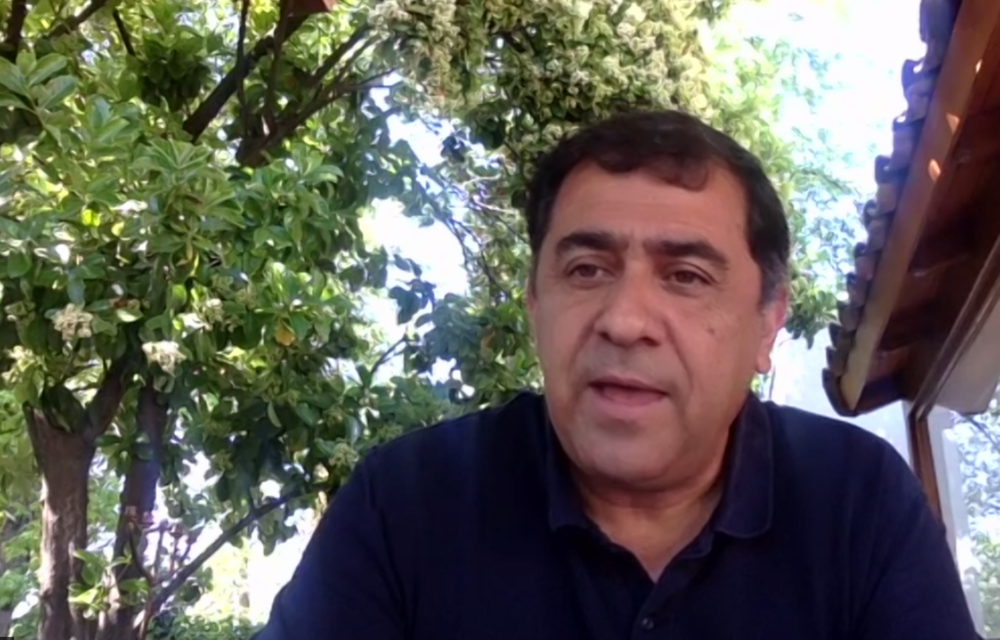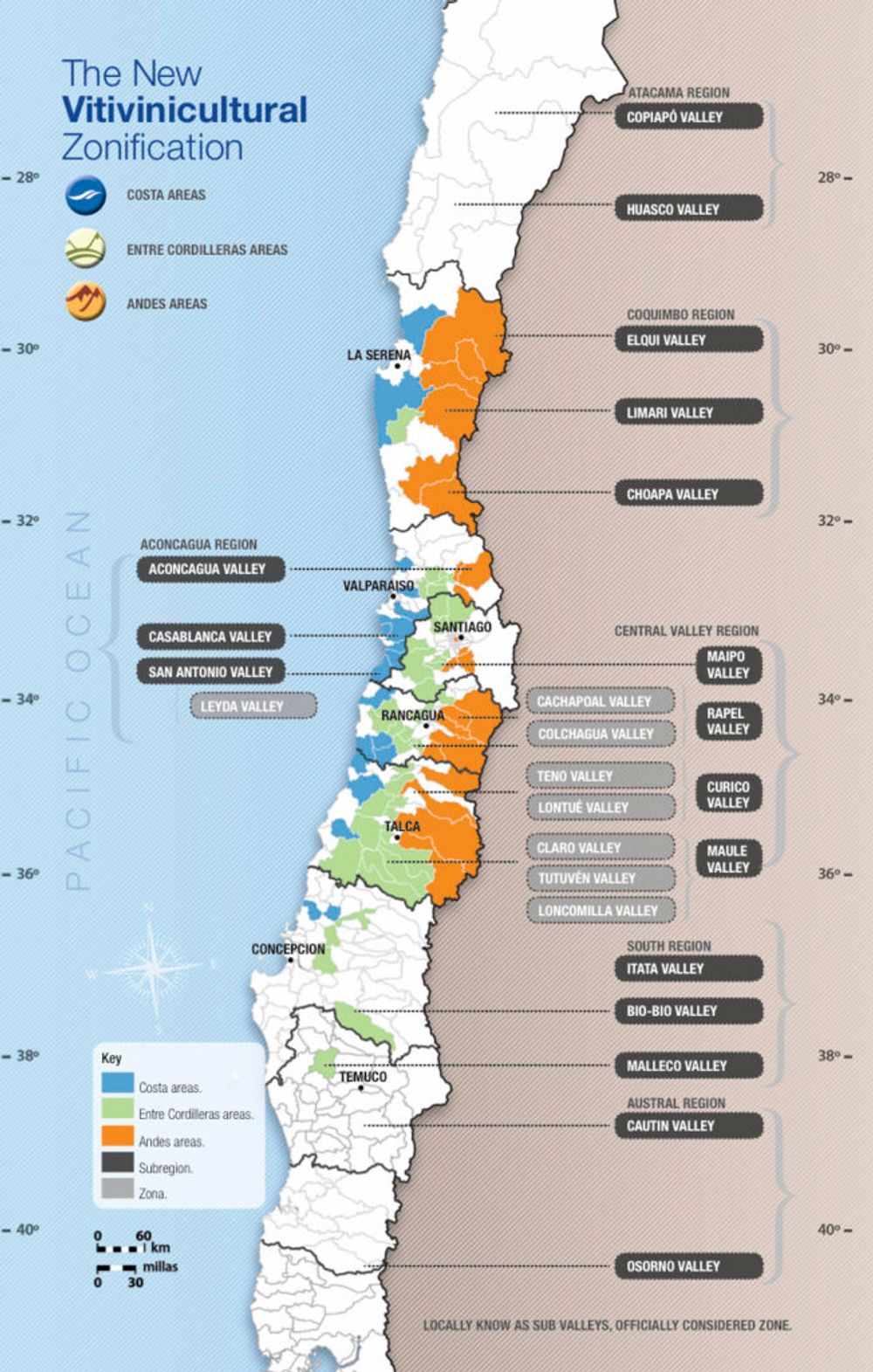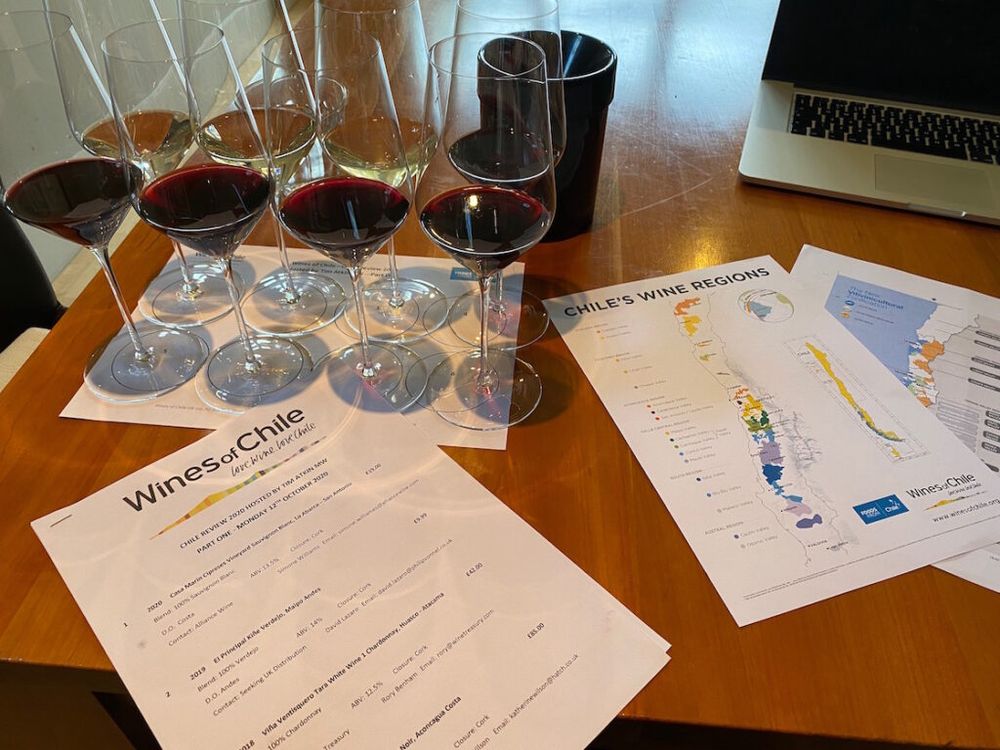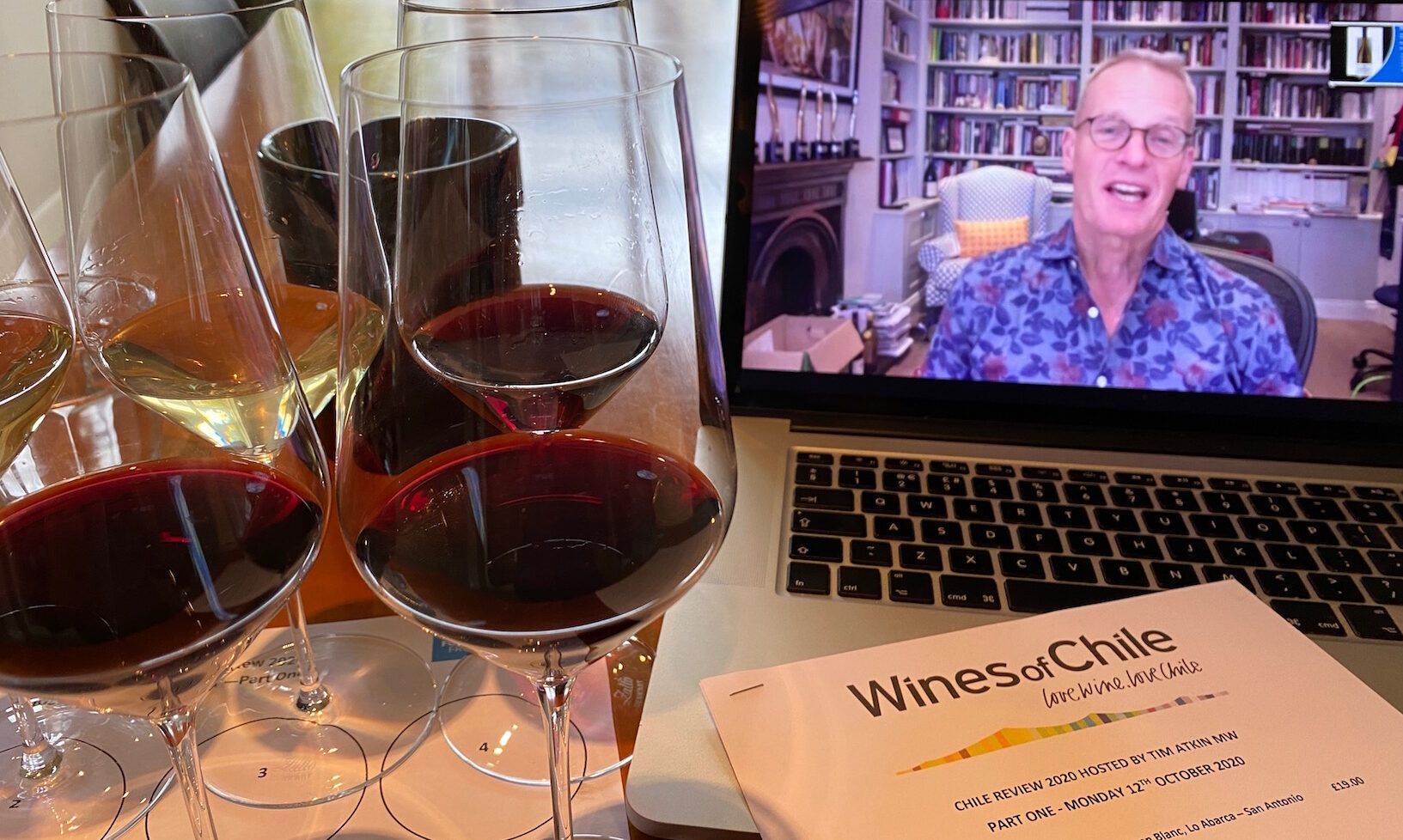“Winemakers, however, will need to keep an eye on how far they dial down – don’t pick too early – and also what they charge. In the first 8-wine flight the La Roncière Licantén Malbec was the only red under £20 (it was about a third of the next least expensive wine),” writes Dean.
As if to reflect the diversity and sheer scale of the amount of good new wine coming out of ‘new Chile in 2020, instead of one online tasting wine writer Tim Atkin MW had to have two online Zoom sessions of eight wines each in order to reflect the varieties, styles, regions and diverse terroir. And for those who took part, especially those who had rather pigeonholed wines from Chile in the past decade, it was a real eye-opener.
16 winemakers introduced the 16 wines Atkin has chosen as his best new wines from this ‘new Chile’, with the new style typified best when Marcelo Retamal, winemaker at De Martino confessed, with some candour, that it had got to the stage where rather than drink his own wines he would open bottles from other producers at the dinner table.

Given up drinking his own wines: Marcelo Retamal, winemaker at De Martino
“The big problem was that I don’t drink my own wine – they were too heavy, oaky, rich, sweet – then I used to pick my grapes very late. But every year I always spend three weeks in other parts of world to open my head and in the beginning of 2010 I was in the Jura, I love the wines here they have more freshness and acidity.”
“So that is the moment I changed, I eradicated acidification, yeast products and we also changed the moment when we pick the grapes. The biggest problem is that everyone follows phenolic ripeness and in Chile when you have seeds ripe you have 16% alcohol and no acidity. The alcohol is not important but the balance is. Now we have one man Don Manuel who makes the wine, we use foudres and have moved away from small, new oak barrels to 5000l foudres which are 22 times bigger therefore have 22 times less flavours of oak. We don’t buy new barrels any more the latest batch are from 2010.”
‘New Chile’ in a nutshell
Atkin’s masterclass started with a quick memory jogger of key facts about Chile as a winemaking nation.
Chile is the seventh largest wine producer in the world with 137,000 hectares of vines. The country is the longest, thinnest in the world with a width of 177km and a length of 4270km “How can Chile not be diverse with a spread like that?!” Atkin asked rhetorically. It has 16 geographical regions, 15 of which have vines, and the country is laced with rivers that (by and large) run from the Andes in the East to the Pacific Ocean in the West. (Interestingly and confusingly there is no region number 13, for superstitious reasons, therefore technically there are only 15 wine regions in total)
Since 2012 the wine regions are grouped into three main regions D.O. Costa, D.O. Andes and D.O. Entre Cordilleras (between the two) with the proximity to the coast being more important, Atkin says, than changes in Longitude. Vineyard heights vary from sea level to 2200 metres. Chile has 86 different grape varieties, 37 of those white.

“Changes in the past decade have seen an increasing focus on site, terroir and soil expressions with the top wines really terroir-focussed and people tend to think of Chile as having very little vintage variation but vintage variation is very important with El Niño and La Niña playing a huge part,” says Atkin.
The last five vintages in a nutshell have been 2016 – wet and cold; 2017 – hot with wild fires; 2018 – a brilliant year, cool, dry, balanced; 2019 – a drought and 2020 very dry.
Of all the facets of Chile winemaking, though, it was the diversity that Atkin stressed with regions having very different levels of rainfall, vintages getting drier and warmer, more dry farming and more organic and biodynamic winemaking which, it is alleged, cope better with changing conditions.
“The styles of wine have changed dramatically,” Atkin continues. In 1997 there was a big change where Chile was influenced particularly by one influential American critic and wines tended to go for very high alcohol and so on, but since 2010 Chile has come back from that – less new oak is being usd and the wines have more of a sense of place.
And so onto Tim Atkin’s best 16 wines from Chile

The tasting took place over two days, 8 wines in each flight, with each winemaker joining the Zoom session to introduce each wine
White wines and Rosé
Casa Marín Cipreses Vineyard Sauvignon Blanc, 2020, Lo Abarca – San Antonio (£19) 100% Sauvignon Blanc D.O. Costa. 13.5%
Expressive, grassy Sauvignon Blanc, concentrated citrus fruit flavours (pink grapefruit), mouth-watering salinity, alcohol and acidity evident on the very long finish – a wine that will age well. The granite and limestone soils with marine deposits mean that the grape bunches grow small with concentrated flavours. 2020 vintage marred by having to pick the grapes earlier than wished for. (Alliance Wine)
El Principal Kiñe Verdejo, 2019, Maipo Andes (£9.99) D.O. Andes. 14%
One of a number of Spanish varieties this producer is working with. The specific terroir is similar to Rueda in Spain where the vines are from. Somewhat closed nose, complex, savoury quality wine that has benefitted from a variety of different vinification and ageing techniques – picked early the fruit sees concrete, wood eggs, batonage, skin contact, the rest in 500l barrels. So much going on on the palate – richness of fruit, bit of spice, nice texture and grip on the finish. (Seeking UK distribution)
Viña Ventisquero Tara White Wine 1 Chardonnay, 2018, Huasco – Atacama (£42) 12.5%
Exciting new wave Chardonnay with a good story to tell. The grapes are grown on salt flats in the Atacama Desert – a heavy irrigation once a fortnight drives the salt lower down in the ground, making growth possible. The wine rests on its lees for at least two years in a mixture of 2500 l foudres and 1000 l eggs made out of limestone retrieved from the desert. There’s a lifted tropical boiled sweet edge to the aromatics, quite honeyed. The palate is tremendous, real tension and saltiness, citrus flesh and a fantastic length. “A bonkers wine – only crazy people would make wine there,” said Atkin. (Wine Treasury)
Hacienda Araucano Clos de Lolol White Blend, 2019 Lolol – Colchagua Valley (£25) Blend: 80% Sauvignon Blanc, 20% Chardonnay D.O. Costa. 14%
“It is unusual to see the two varieties in the same wine but Francois Lurton (whose biodynamic property this is) doesn’t like to replicate the same formula. He extracts the best of the terroir and then adds French knowhow,” says winemaker Diego Vergara.
Unsurprisingly the wine has similar characteristics to a white Graves. Complex, notes of guava, saline, touch of menthol-like local herb, silky mouthfeel and lovely fine texture.
Unlike the rest of Colchagua Lolol does not have granitic soils, but clay soils that produces a very fine texture. The fruit is fermented separately 30% fermented and aged in steel 70% in 400l new oak, there is n malolactic fermentation. (Condor Wines)
Bouchon Granito Semillón, 2018 – Maule Valley (£32.50) D.O. Entre Cordilleras. 13.5%
Sémillon used to be Chile’s most planted grape (as was the case with Argentina and South Africa too) with over 17,000 ha, today that figure is 798ha – it is now the fifth most planted.
This fourth vintage of what is Tim Atkin’s white wine of the year from Chile has spent 12 months in French oak and has a wonderful intensity, freshness, mouthfeel, high acidity (7.4 g/l) and a smash of citrus on the incredibly long finish. The high acidity incidentally takes away the need to blend with Sauvignon Blanc as is often the case with Semillon. (Condor Wines)
Tabalí Pedregoso Rosé de Pinot Noir, 2019, Limarí Valley (£12) Pinot Noir D.O. Costa. 12.5%
Tim Atkin’s rosé of the year is this first vintage of Pinot Noir that was planted in 2011. Winemaker Felipe Müller explained that this vineyard was planted with Rosé as the final destination unlike a lot of rosé where the winemaker is picking according to fruit for the red wine. As a result this wine has high acidity, a low residual sugar of 1.7 g/l after having been fermented in steel for 21 days.
The wine is fresh, with floral fruit (strawberries, water melon), lovely and creamy, very dry – which comes from a mix of the cool climate, limestone soil and early picking. (Boutinot)
Casas del Bosque Late Harvest Riesling, 2018 Casablanca (£14) D.O. Costa. 12%
2018 was a cracking vintage in Chile but harder for botrytis, obviously, on account of the dry, sunny conditions, according to winemaker Meinard Bloem.
40/50% of the fruit (grafted in 2008 onto Merlot vines) had natural botrytis resulting in an r/s of 184 g/l, where their goal is 120 g/l. The acidity is moderate to high 6.6 g/l. Getting the abv up was difficult, especially as under 11.5% the end product is not legally wine in Chile.
The wine has been fermented in 5thuse French oak barrels for six weeks, then racked into steel. The resulting wine has subtle oak notes and the Volatile Acidity kept under-threshold. “We have done away with new oak – just have old barrels for complexity,” said Bloom. (ABS Wine Agencies).

Red wines
Errázuriz Las Pizarras Pinot Noir, 2018, Aconcagua Costa (£85) D.O. Costa. 13%
A trip to Burgundy and a realisation that Chile could make wine with a fresher style and more moderate alcohol, were influences behind the setting up of this wine said winemaker Francisco Baettig. 15% whole bunch was used on this vintage (now gone up to 20%) because the vines were young and the wine needed more texture and structure. Manganese and iron in the soil gives this very Burgundian wine iron, iodine and slight bloodiness to the wine. The nose is a mix of youthful, ripe red fruit, with sous bois and mocha overtones. The palate is fresh, elegant and tightly wound. (Hatch Mansfield)
Viña Leyda Lot 21 Pinot Noir, 2018 Leyda Valley (£29.50) D.O. Costa.13.5%
Viviana Navarrete, winemaker at Leyda was Tim Atkin’s winemaker of the year from Chile. She explained that 75% of the estate’s output now is Sauvignon Blanc and Pinot Noir, of which this is one of five, coming from a total of 85 hectares of the grape.
Her top Pinot used to be 100% massal selection but now it is a mix with massal and clonal. “Clonal selections is really the only way to improve the quality of your wines in the final blends,” she said stressing the importance of Clone 777 which brings up red acid profile of the fruit, giving raspberries, and making the wine sinewy and long – all of which was apparent in the wine on tasting – floral, red fruit, lean, textured palate, sinewy, with real elegance.
In 2015 the winery did extensive research into the soil types and now uses those learnings in informing the final blend in terms of fruit profile and mouthfeel – moving away from their darker, creamier style. They also ferment and age in 31% barrel, 18% foudres and 51% cement with Navarrete describing “wood is the enemy”. She also described a social project she is working on where the winery has given 2.5 hectares to six families of indigenous people in the South.
“We thought we would help educate them and tend the vines but they are naturally linked into nature – they have a relationship with nature and have it naturally in their blood – the result is that they have taught us many things,” she says. (Enotria & Coe)
La Roncière Licantén Malbec, Licantén, 2018, Curicó (£13.95) Blend: 85% Malbec, 8% Merlot, 7% Cabernet Franc. D.O. Costa. 14%
Despite this being vinified in 100% new wood this is a fresh, lovely clean style of Malbec, with a mineral core, red and black fruit, lick of vanilla, great length, fine-grained texture, citrus rasp on the finish. Very well balanced with the wood very well integrated. Winemaker Juan A Munõz says that his background in making sparkling wines helps with the freshness in his still wines, although the greatness of the 2018 vintage throughout Chile has resulted in the wines having extra freshness. Very good value for money. (Corney & Barrow)
Maquis Viola, 2016, Colchagua Valley (£40) Blend: 88% Carmenere, 9% Cabernet Franc, 3% Cabernet Sauvignon. D.O. Entre Cordilleras. 13.5%
This wet and cool vintage threw big curve balls to winemakers throughout Chile. Winemaker Ricardo Rivadeneirasaid just when he thought they would have an early harvest “the sun didn’t come back for 3-4 weeks, maturity stopped, it was as if the grapes had been put into the refrigerator.” The resulting wine is very good indeed, terrific elegance, finesses, great balance with red fruit and floral qualities (very little extraction, bell pepper or chocolate notes); the wine has a nicely rounded palate, with fine, dry finish. (HispaMerchants)
De Martino Old Vine Series VIGNO, 2018, Maule Valley (£35) Blend: 85% Carignan, 15% Malbec & Cinsault. D.O. Entre Cordilleras. 13.5%
Part of the VIGNO old vines project in Chile, this Carignan-led blend has been aged for two years in 5,000l oak foudres. Deep purple/ black with bright purple edging; attractive bloodiness and savoury meat juices, along with the black fruit and herbal notes; the palate is fresh, bright and precise, with juicy black berries; there is considerable depth to the mid-palate, an intensity but fresh, fine-grained texture; quite a structured wine with ripe, firm tannins. (Enotria&Coe)
Los Vascos Le Dix, 2016, Colchagua Valley (£45) Blend: 85% Cabernet Sauvignon, 5% Syrah, 5% Carmenere, 5% Cabernet Franc. D.O. Entre Cordilleras. 14%
The only Cabernet Sauvignon of any kind shown in the eight wines from Part One of Atkin’s Best Wines review – Cab Sauv being Chile’s most planted grape and the one most commonly associated with the country. A difficult vintage with unprecedented rain during harvest, has made 2016 have comparisons drawn between this and 1998. The team picked two weeks earlier than normal, this bold, structured wine having a delicious fresh, crunchy fruit profile as a result. It’s a mash-up of black fruits (fresh blackcurrants) with high acidity and firm tannins with a not unattractive grippy edge. Ageing is in a mix of formats 50% new oak barrels, 30% second fill and the rest in concrete, all barrels coming from Lafite. (Waddesdon Wine)

Cristian Vallejo, talking about VIK
VIK, Millahue, 2016 – Cachapoal (£99.95) Blend: 74% Cabernet Sauvignon, 26% Cabernet Franc. D.O. Entre Cordilleras. 13.9%
Having got rid of Carmenere and Merlot in the blend the 2016 VIK marks a real shift in style – this is a shift of style. Winemaker Cristian Vallejo describes how within the estate’s 320 hectares of planted vine he has 360 plots with “a lot of micro-soils, meaning I can choose lot of different flavours.”
The wine spent 24 months in 75% new French oak (for micro-oxygenation rather than the flavour of the oak) with 1stand 2nduse barrels increasingly being used since 2013 “More to show the real flavour of this special terroir,” Vallejo says. “Having high density of vines – with very low yield per vine – brings out round tannins in the wine and enhances the freshness of the acidity. They are fresh, vibrant tannins but not angled – you get tension – like they are moving – but they are round as well,” he added.
The finished wine is very structured, has fantastic depth of fruit flavours, vibrant tannins but ripe and soft tannin at the same time. (Slurp)
Odfjell, Cauquenes, 2015, Maule (£50) 100% Cabernet Sauvignon D.O. Entre Cordilleras. 14.5%
Odfjell’s winemaker Arnaud Hereu comes from Bordeaux so it was unsurprising that even with five years on the clock this fabulously structured Cabernet Sauvignon from the very old wine region of South-Central Maule would need another five-ten years in the bottle.
It is a rare grape from this neck of the woods, the region that houses the country’s VIGNO project. It is also a hard place to grow vineyards, with red clay soil, a lot of wind and no water. Wines from here have a lot of tannin, and all varieties except Carignan a lot of structure. “Therefore we don’t extract too much,” says Hereu.
Having been fermented 24 months in French oak, the wine is a powerhouse with chunky structure and high alcohol but even at 15% the balance is there through the high acidity. “Slightly rustic,” Atkin commented. This was the only 100% Cabernet Sauvignon shown out of 16 wines. (Alliance Wine)
Montes Outer Limits Syrah, Zapallar, 2019, Aconcagua Costa (£20) D.O. Costa. 14%
Winemaker Aurelio Montes Jr described how they looked for an extreme cold place to plant Syrah (away from the more traditional region of Colchagua), where there is fog every day and even on hot days it is only warm for a couple of hours. They found this 2km inland from the high end resort of Zapallar.
Montes uses 35% 2ndand 3rduse oak barrels for 12 months, with the remainder of the fruit in concrete eggs, 30% fermented with stems. With the decision not to use any new oak, the wine has a real crispiness and spiciness. Classy cool climate Syrah with notes of pepper and spice, liquorice, fresh and fragrant, crispy, lovely texture and firm, ripe tannins. (Liberty)
All prices are retail and inclusive of VAT and duty.
Footnote
This impressive tastings series showed how Chile has listened to the world and dialled down on the heavy, oaky, rich, sweet wines that were beginning to turn off wine drinkers – certainly those above the entry level drinker. There was less extraction, less reduction and a crunchy freshness to all the wines that will surprise drinkers who haven’t kept up with the direction of ‘new Chile’. Winemakers, however, will need to keep an eye on how far they dial down – don’t pick too early – and also what they charge. In the first 8-wine flight the La Roncière Licantén Malbec was the only red under £20 (it was about a third of the next least expensive wine) and at £13.95 RRP represents outstanding value for money, the wines around the £40 mark may need a fair wind and some good fortune in the on-trade, irrespective of how well made and ‘new’ they are. But an eye-opener on new Chile all the same.









































